
Ants under the microscope: explore their hidden and amazing world
Ants, these small creatures with fascinating behavior, hide a secret world waiting to be discovered. Thanks to a microscope, we can explore their invisible universe and understand the mysteries that surround them. By observing these insects up close, we discover their lifestyle, their social interactions, and the astonishing characteristics of their anatomy. In this article, we will dive into the world of ants under the microscope and reveal some surprising revelations!
The wonders of ant anatomy under the microscope
An overview under the microscope
Microscopes offer a unique perspective on ants. To the naked eye, they appear simple, but under the right magnification, their anatomy becomes breathtaking. The details of their six legs, their sensitive antennae, and even their compound eyes are revealed. For example, each of an ant's legs is composed of several jointed segments, allowing for great agility. Imagine the complexity and beauty hidden behind their seemingly ordinary appearance!
The fascinating internal structures
Internally, ants possess highly specialized organs. Their mandibles, for example, are not only used for chewing, but are also adapted for transporting materials and building their nests. Microscopes allow us to observe the serrations on these mandibles, proving their efficiency. These details, invisible to the human eye, demonstrate the incredible adaptations ants have to their environment.
Social behavior of ants
A complex organization
Ants are known for their elaborate social lives. By observing colonies under a microscope, we can see how they interact and organize themselves. Worker ants, for example, work together to feed the queen and care for the young. This cooperation is evident in the placement of eggs and larvae within the nest. A microscope provides a privileged glimpse into the social relationships within the colony, such as their chemical signals and the ways they communicate.
The use of pheromones
Another fascinating aspect of their behavior is the use of pheromones. These chemicals, imperceptible to us, play a crucial role in communication. Using a microscope, it's possible to observe how ants "mark" paths with these pheromones, thus guiding other members of the colony. It's as if they were tracing a map in the soil, revealing the hidden workings of their world.
Reproduction in ants
The different castes
Ant colonies typically consist of several castes, each with a specific role. By examining samples under a microscope, we can distinguish between queens, soldiers, and workers. The queen, often much larger, is responsible for reproduction. Microscopes also show us the structural differences between these castes, which is essential for their function within the colony.
Stages of development
The development of an ant, from egg to adult, is a fascinating process. Using a microscope, we can follow the various stages, from larva to pupa. Each transition takes place in a protected environment, often by lowering the larvae into special cells. During these moments, careful observation under a microscope can reveal internal developmental details, revealing the complexity of their life cycle.
The challenges of microscopic observation
Observation techniques
Observing ants under a microscope requires specific techniques. To obtain sharp images, it is crucial to properly prepare the samples. This may involve the use of mild chemical treatments to preserve details. Furthermore, the choice of microscope is essential—a light microscope or an electron microscope could offer very different perspectives. The challenges of achieving clear and precise focus are often the key to understanding these complex creatures.
Common mistakes to avoid
When hobbyists begin observing ants under a microscope, it's common to make certain mistakes. For example, neglecting to properly secure the specimen can lead to unexpected movements. Additionally, using too high a magnification at first can simply create a confusing view. Here are some recommendations:
- Start with low magnification to understand the general structure.
- Use adequate light to illuminate the sample.
- Take notes during the observation to facilitate later comparisons.
Conclusion
In conclusion, observing ants under a microscope allows us to enter an invisible world, revealing fascinating facts about their anatomy, social behavior, and life cycle. Every detail, from the functioning of their mandibles to pheromone communication, illustrates the complexity and sophistication of these insects. Using a microscope therefore becomes an essential tool for anyone wishing to understand the hidden realities of these incredible creatures. Whether you are an insect enthusiast or simply curious, exploring the world of ants with a microscope could stimulate your interest in biology and evolution.
FAQ
Why use a microscope to observe ants?
Using a microscope allows us to observe details invisible to the naked eye, which is essential for understanding their anatomy and behavior.
What type of microscope is best for examining ants?
A biological microscope is usually sufficient for observing ants, but an electron microscope can provide even finer details.
How to prepare ants for microscopic observation?
It is important to secure them properly and ensure the sample is clean to obtain clear images. A good practice is to use a glass holder or suitable stand.
Right now, get 10% off BBChoupette with promo code BLOG10 . Discover microscopes to help your little ones learn at their own pace.






